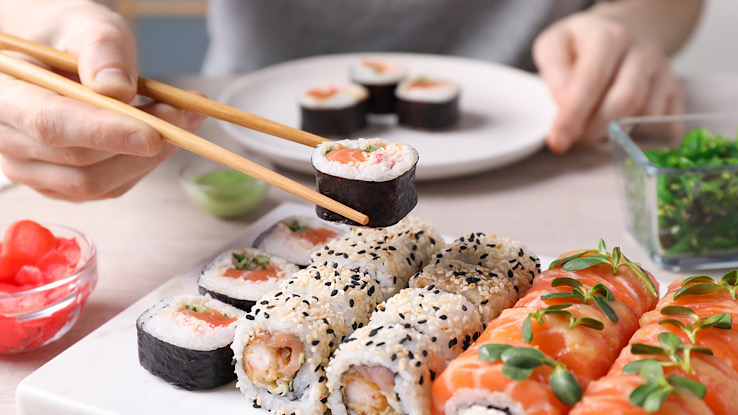
The word “sushi” is often synonymous with “raw fish,” which is valid for the most part, but some sushi dishes are cooked, while others contain no fish or seafood at all. This Japanese delicacy has grown to be quite popular worldwide as more and more people discover sushi’s unique textures and robust flavors. However, there are still many people who are skeptical about eating entirely raw seafood.
Read on to discover the health benefits and possible dangers of eating sushi and raw fish.
What Is Sushi?
To put it into simple terms, sushi is indeed raw fish over or in a clump of rice.
Sushi is one of the most popular dishes in Japanese cuisine and is probably the most famous worldwide. Sashimi is raw fish without rice. However, not all sushi is served raw.
Certain sushi dishes, like unagi (eel) or Ebi (shrimp), are cooked in some form. Popular, Westernized sushi rolls like the California Roll or the Crunchy Roll found in many restaurants also feature cooked seafood. Sushi can also include dishes containing no seafood, where the main ingredient might be vegetables or even eggs.
Is it Safe to Eat Sushi?

As scary as eating raw fish may sound, one must understand that the fish used at a reputable sushi establishment is of the highest quality. A reputable sushi establishment will also follow the highest food safety standards to ensure that their dining guests do not fall ill from their food. Industrial freezers, proper fish freezing and storage, and the use of sushi-grade seafood are essential factors for protecting patrons against foodborne illness. So, if it’s a trusted establishment with reputable safety standards, feel free to enjoy your sushi happily.
Health Benefits of Eating Sushi
Sushi also has some health benefits like:
- Having omega-3 fatty acids
- Being an excellent source of protein
- Having lots of vitamins and minerals, like calcium and vitamin D.
Aside from the rice and perhaps adding too much soy sauce, sushi is a very healthy dish that can benefit one’s health.
Dangers of Raw Fish
You should cook seafood thoroughly to decrease the risk of foodborne illnesses. Possible health risks if you ingest raw fish are:
- Abdominal pain
- Diarrhea
- Vomiting
- Nausea
- Parasites as tapeworms
- Food poisoning with toxins or bacteria like salmonella
If you experience symptoms after eating raw fish, including sushi, you should seek medical help immediately.
Other Precautions
Due to the levels of mercury found in some seafood and the potential health complications from foodborne illnesses, the FDA recommends that certain people should avoid the consumption of raw fish:
- Pregnant women
- Women who are still nursing
- Older adults
- People with weakened immune systems
- Anyone with low stomach acidity
- Those who may suffer an allergic reaction to certain seafood, like shellfish
Before eating sushi or any seafood, cooked or uncooked, make sure you talk to your doctor.
Resource Links:
- “Possible food safety hazards of ready-to-eat raw fish containing product (sushi, sashimi)?” via Critical Reviews in Food Science and Nutrition
- “Sushi Delights and Parasites: The Risk of Fishborne and Foodborne Parasitic Zoonoses in Asia” via Clinical Infectious Diseases
- “Risk estimation to human health caused by the mercury content of Sushi and Sashimi sold in Japanese restaurants in Brazil” via Journal of Environmental Science and Health
- “Modeling Some Possible Handling Ways with Fish Raw Material in Home-Made Sushi Meal Preparation” via Foods
- “A review of guidance on fish consumption in pregnancy: Is it fit for purpose?” via Public Health Nutrition





